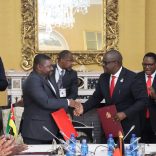Mozambique: Education Minister acknowledges delay in overtime payments - Watch
Mozambique: Credit to economy rises for third month to highest level this year

File photo: Banco de Moçambique
Credit to Mozambique’s economy grew in July for the third consecutive month, to 247.716 billion meticais (€3.470 billion), the highest figure since the beginning of the year, according to official data from the Bank of Mozambique’s latest statistical report.
This performance represents a 1% increase on the volume of credit to the economy granted by Mozambican banks in June, which then totalled 245.357 billion meticais (€3.437 billion).
Loans to individuals continue to lead and have been growing since the beginning of the year, reaching 94.598 billion meticais (€1.325 billion) in July, also the highest figure in at least a year.
This was followed by the transport and communications sector, whose total credit granted by banks fell slightly to 26,055 million meticais (€365 million) in July, the manufacturing industry, which increased to 25,272 million meticais (€354 million), and commerce, with 24,604 million meticais (€344.6 million).
The reference interest rate for credit operations in Mozambique remained at 21.2% in September, for the second month running, in a decision by the Mozambican Banking Association (AMB).
The rate, known as the prime rate, had been falling since 2018, reaching a low of 15.5% in February 2021, when the trend reversed and the rate began to rise until it reached 24.1% in July last year.
After six consecutive months at highs of 24.1%, the rate fell to 23.50% in January 2024, in March to 23.10%, in April to 22.70%, in May to 22.30%, in June to 22.0% and in July to 21.2%.
The increases in the prime rate are linked to the rise in the monetary policy interest rate (the MIMO rate, which influences the formula for calculating the prime rate) by the central bank in order to control inflation.
The Monetary Policy Committee (CPMO) of the Bank of Mozambique decided on 31 July to lower the main MIMO interest rate from 15% to 14.25%, justifying it with the prospect of inflation remaining in single digits in the medium term.
“This decision is underpinned by the continued consolidation of the inflation outlook in single digits in the medium term, in a context where the uncertainties associated with the projections remain favourable,” said the governor of the Bank of Mozambique, Rogério Zandamela, during the presentation of the measures taken by the CPMO.
The creation of the prime rate was agreed in 2017 between the central bank and AMB to eliminate the proliferation of reference rates on the cost of money.
At the time, it was launched at 27.75%.
The aim is for all credit operations to be based on a single rate, plus a spread that is added to or subtracted from the “prime rate by analysing the risks of each contract, officials explained.












Leave a Reply
Be the First to Comment!
You must be logged in to post a comment.
You must be logged in to post a comment.